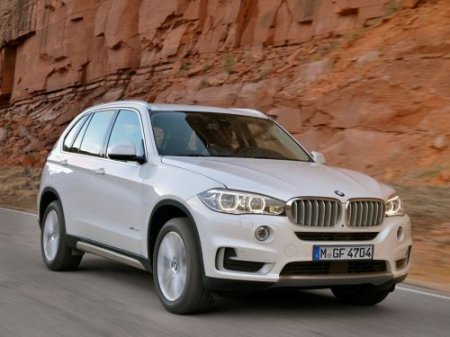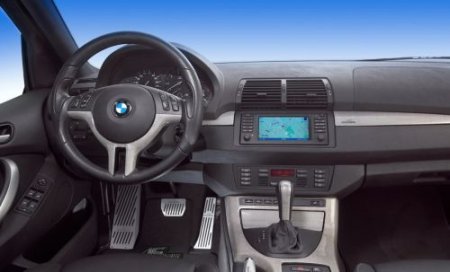
BMW X5 fuel consumption details
Content
The first full-fledged German SUV appeared in Detroit in 1999, already showing good performance. The first model had a 3.0 engine and a power of 231 hp, which provided the fuel consumption of the BMW X5 in the combined cycle of approximately 13.2 liters, which is a good indicator for that time.

Briefly about the model
BMW is still a symbol of prosperity, and the owner who arrives in the X5 acquires a special status. This model is characterized by high safety and durability of the body. The 2003 Euro NCAP crash test showed five stars out of five. Satisfactory fuel consumption figures were also noted.
| Engine | Consumption (track) | Consumption (city) | Consumption (mixed cycle) |
| 4.4i (petrol) | Xnumx l / xnumx km | Xnumx l / xnumx km | Xnumx l / xnumx km |
3.0d (diesel) 313hp | Xnumx l / xnumx km | Xnumx l / xnumx km | Xnumx l / xnumx km |
3.0d (diesel) 381hp | Xnumx l / xnumx km | Xnumx l / xnumx km | Xnumx l / xnumx km |
The original body of the supporting structure. Independent suspension of all wheels. Like all BMWs, the X5 has an emphasis on rear-wheel drive (67% of the torque). The powerful engine accelerates from 0 to 100 kilometers per second in 10.5 seconds. According to customer reviews, real fuel consumption of BMW X5 per 100 km on average up to 14 liters in the combined cycle.
BMW X5 is equipped with all possible programs ABS, CBC, DBC and so on. All this, combined with beautiful design, made the series a success. Every 3-4 years it was updated to compete with similar models.
More about TX
As mentioned above, for 2000 the characteristics of the car were impressive. Manufacturers tried to ensure that BMW X5 models did not stagnate for a long time, and constantly improved certain indicators.
1999-2003
Initially, the following configurations were available:
- 0, power 184/231/222, mechanics / automatic, diesel / gasoline;
- 4, power 286, automatic, gasoline;
- 6, 347 hp, automatic, gasoline.
More powerful BMW models received an eight-cylinder V8 engine and an automatic gearbox. Of course, this combination has affected the fuel consumption of the BMW X5. According to technical documentation, the urban cycle requires up to 21 liters, and on the highway - 11.4.
If we talk about cars with a volume of 3.0, then they got the L6 engine. And if we compare the spending on the urban cycle with more powerful models, then the consumption, taking into account the mechanics, is less by 4 liters. Average fuel consumption of the BMW X5 on the highway is 10 liters. Such indicators are considered to be quite economical, therefore this particular model was more popular.
2003-2006
Three years later, an updated lineup was released. The design was slightly changed (headlights, hood, radiator grille), but the main innovation was the redesigned XDrive all-wheel drive system.
In addition, the BMW X5 series received two new engines. Namely 4.4 V8 gasoline and L6 diesel with Common Rail system. Regardless of the model, the manufacturer allows the buyer to choose a mechanic or automatic, which significantly affected the average fuel consumption of the BMW X5 on the highway and in the city.
The diesel accelerates to 100 km / h in 8.3 seconds at a top speed of 210 km / h. Wherein if you avoid abrupt starts in the city, the fuel consumption of the BMW X5 will be up to 17 liters. On the highway - 9.7 per hundred kilometers.
4.4 and 4.8 consume a little more fuel. 18.2 and 18.7 in the city, respectively. At the same time, the fuel consumption on the highway per 100 km will be no more than 10 liters of the resource.

2006-2010
The second generation of BMW SUVs has changed, first of all, externally. The new body was 20 centimeters longer, and another row of seats was installed inside. A total of 7 people could enjoy the ride. The design has been slightly improved, this is especially noticeable in the headlights.
Updated electronics made the ride more comfortable. There were also minor changes to the engines. In 2006, a 6 and 3.0 L3.5 diesel / petrol was available, as well as a 4.8 petrol eight-cylinder engine. All cars of this generation were originally produced exclusively with automatic transmission.
Fuel consumption rates for BMW X5 (diesel):
- urban cycle - 12.5;
- mixed - 10.9;
- on the highway - 8.8.
If we talk about the most powerful model in this series, then it does not differ in such savings. The fuel consumption of a BMW X5 with a volume of 4.8 in the city is 17.5. Route - 9.6.
2010-2013
The successful car was restyled in 2010. In terms of design, it has become a little more aggressive. One has only to look at the ring of LEDs around the headlights. At the same time, the internal interior has practically not been changed.
Manufacturers have focused on the engine. All BMW X5 engines have become more powerful and more economical, which can be seen in fuel consumption. Under the hood of the new X5 were installed:
- petrol 3.5, 245 HP, L6;
- petrol 5.0, 407 HP, V8;
- diesel0, 245 hp, L6;
- diesel0, 306 hp, L6.

All engines comply with the European standard for the emission of toxic substances into the atmosphere. If we talk about fuel consumption, then the cost of gasoline for the BMW X5 in the city is 17.5, and on the highway 9.5 (engine 5.0). Diesel cars "eat" 8.8 liters of fuel in the urban cycle and 6.8 liters in the suburban cycle.
2013-NV.
The third generation BMW X5 made its first appearance at the Frankfurt Motor Show. The body was practically not changed. However, some changes were made, for example, the stiffness was increased by 6% and the shock absorbers were retuned for a more comfortable ride.
Appearance. The hood was slightly lengthened, the headlights were changed. The air intakes have also acquired a new look. In addition, the lard has become more spacious.
As for the engines, the base is 3.0 L6 and 306 horsepower. It accelerates to 100 km / h in 6.2 seconds.
On the box, an automatic machine in the urban cycle is considered to be the norm up to 12 liters and 9 - in the suburban cycle. The diesel in the combined cycle boasts up to 10 liters of fuel in the city and up to 6.5 on the highway.